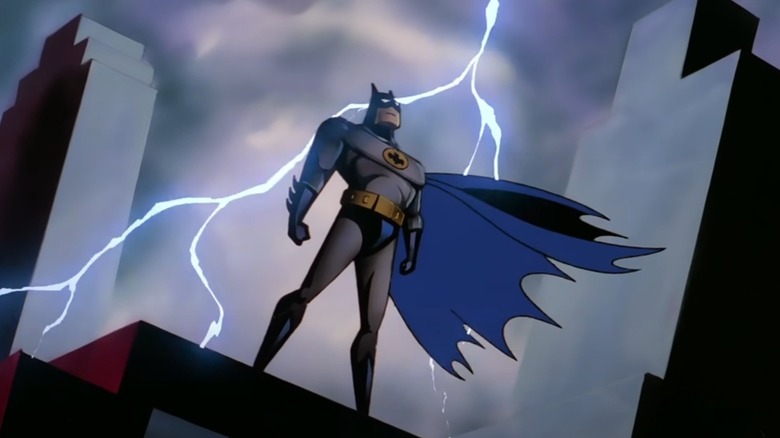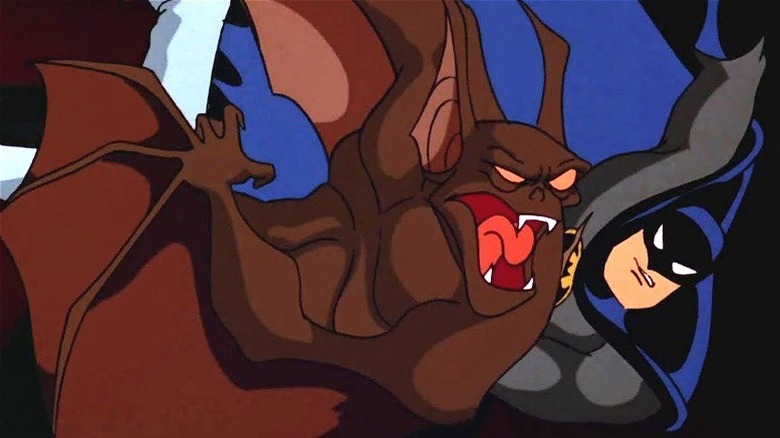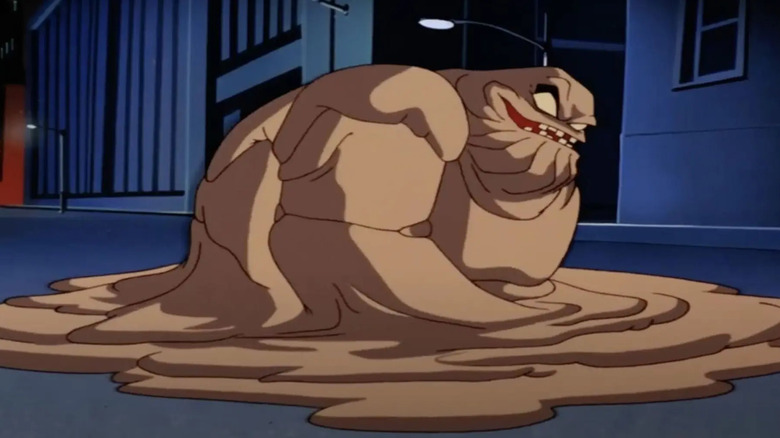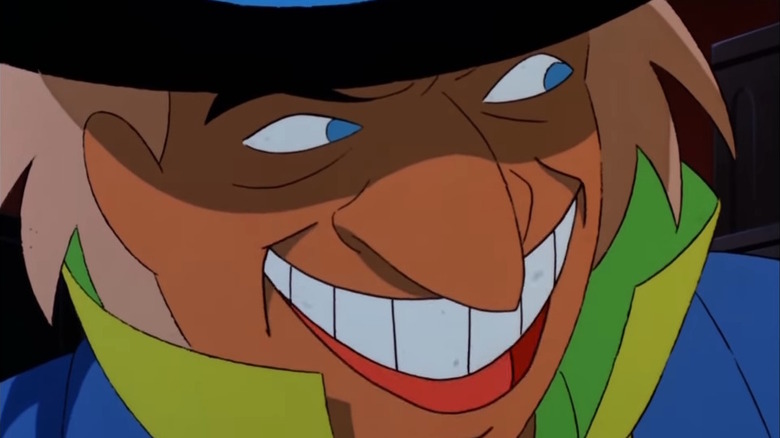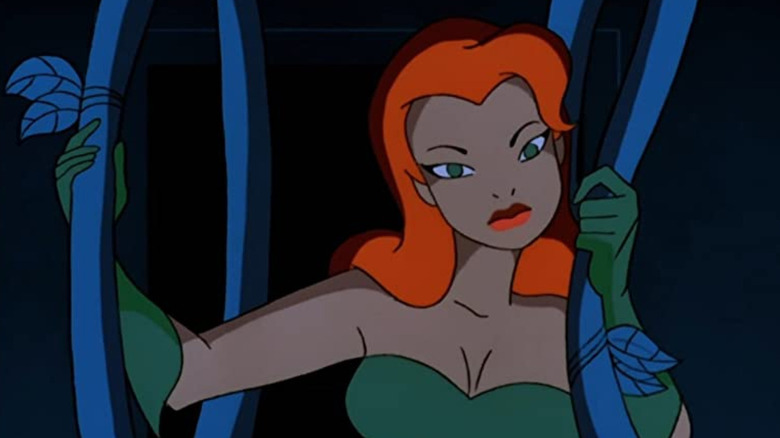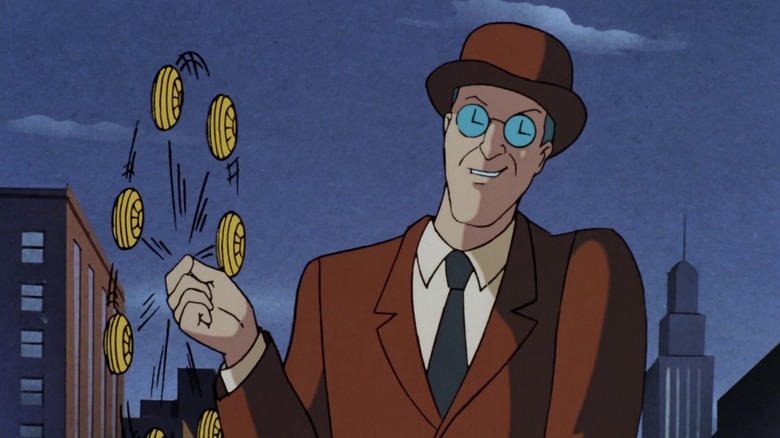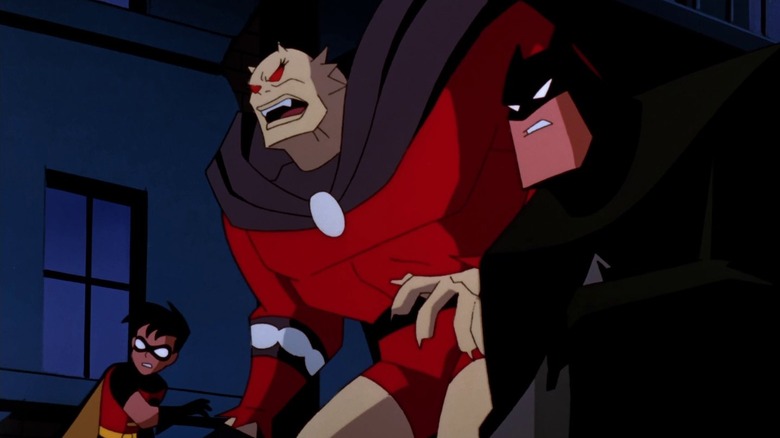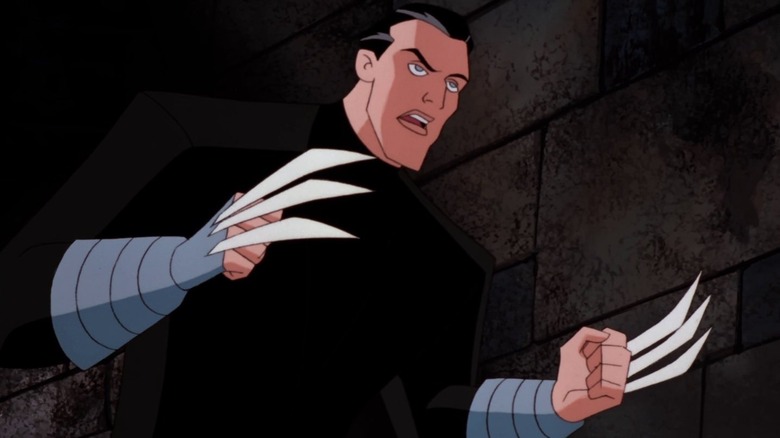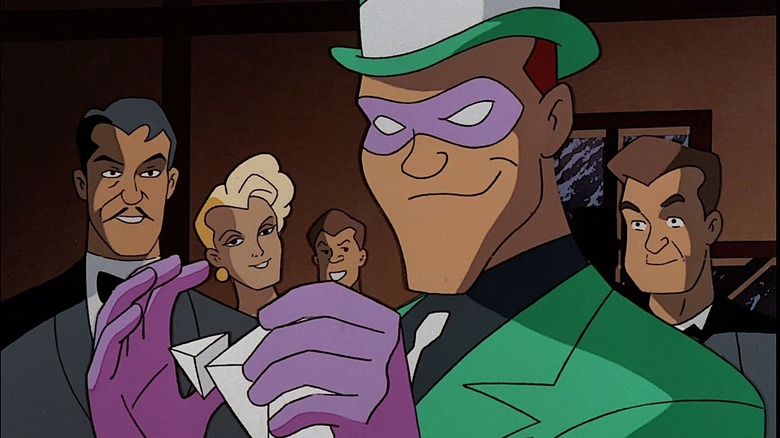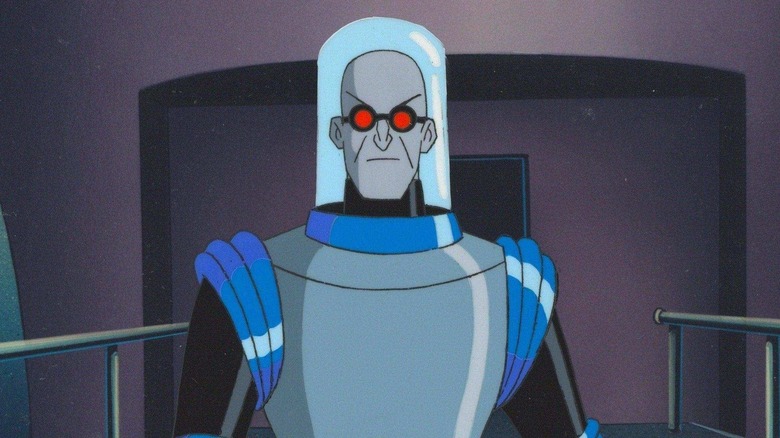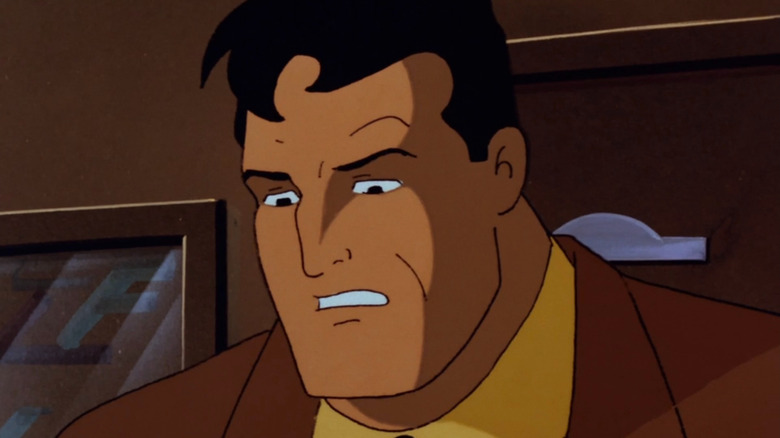10 Characters Who Are More Powerful In Batman: The Animated Series Than In The Comics
"Batman: The Animated Series" remains one of the most fondly remembered incarnations of the Dark Knight, with new fans still discovering it (and old fans revisiting it) on HBO Max. Writer Paul Dini and artist Bruce Timm spearheaded the creation of a cartoon that elevated the art form, with character designs, scripts, and voice acting that was head and shoulders above anything going on a the time. The show released 85 episodes on Fox between 1992 and 1995 and was revived and retooled in 1997 as "The New Batman Adventures" for 24 more episodes on the CW.
The animated series struck a more realistic tone (especially in the pre-"New Adventures" days), which means a lot of characters were powered down from their comic versions. For example, the episode "Zatanna" introduces the DC character by that name. While the Zatanna of the comics is a powerful spell-caster, this animated version is just a stage illusionist.
Still, a few characters did get powered up for the series, whether as an intentional story choice or just a side effect of other elements. So with that in mind, here are the ten characters who became more powerful in "Batman: The Animated Series" than they were in comics.
Man-Bat
Man-Bat was inevitable. Despite his name, Batman isn't a hybrid of human and bat. He's just a smart, rich guy in a cool costume. Still, Batman lives in a colorful world full of comic book science and superpowers. Eventually, he had to fight somebody who actually is a bat-human hybrid. Like most comic book monsters, Man-Bat was originally a scientist who'd experimented on himself. Zoologist Kirk Langstrom took a special bat serum (the reasons vary with different versions of the story) and turned into a humanoid bat.
When Man-Bat first appeared in "Detective Comics" #400, he was very much a Mister Hyde-type character (as in Robert Louis Stevenson, not Marvel Comics). He skulked around in the shadows, wearing a long coat and hiding his inhuman nature until the climax. It took a while for Langstrom's alter ego to take to the sky, and even after he did, he was always kind of a funny-looking guy — a human-sized, furry creature with wings for arms and enormous ears.
In contrast, the animated Man-Bat was rather frightening for a cartoon character. Although the animated Langstrom is much the same, his other half is a hulking, hunchbacked monster with enormous leathery wings. He's first seen gliding mysteriously past a police dirigible in the episode "On Leather Wings." Of course, Batman ultimately defeats this bigger, stronger Man-Bat, but the creature's fearsome appearance helped to establish the fearlessly groundbreaking nature of "Batman: The Animated Series."
Clayface
The original comics' Clayface, Basil Karlo, didn't have superpowers; He just had a creepy mask. Matt Hagen, the Silver Age version, was the guy made of mud who could shapeshift. He was still pretty human, however. His powers were only temporary, requiring him to bathe regularly in the secret pool of radioactive protoplasm that transforms him. Even in Clayface form, he's still the shape and size of a human, just made of mud. Then came Preston Payne, who accidentally transformed into a claylike state while trying to reshape his deformed face into something handsome and ended up having to wear a containment suit to hold himself together.
The animated Clayface contains elements of all three. He has Hagen's name and powers, albeit amped up. Like Karlo, he's an actor whose career is in trouble. Like Payne, he's trying to fix his face. Although this version was disfigured in an accident rather than born with a disorder. Nevertheless, the Clayface who first appears in the two-parter "Feat of Clay" is unlike any of those who came before. He's not a man made of clay like Matt Hagen was in the comics; He's a huge, nearly shapeless pile of clay that (sometimes) walks like a man. In one story, he does have to wear a containment suit like Preston Payne's, but in general, his powers seem to be pretty much unlimited. Not only can he imitate anyone (somehow doing the voice as well as the face) and make his limbs into weapons, he can create separate people out of parts of his mass and even give them a degree of individuality and sentience. At that point, you're coming awfully close to creating life, which is pretty darn powerful for a Clayface.
Mad Hatter
In the old days, the Mad Hatter (also known as Jervis Tetch) was mostly just obsessed with hats. He'd rob hat museums, try to steal Batman's cowl — that sort of thing. As he evolved into a more formidable and enduring villain, his gimmick became mind control. After all, hats are perfect for controlling people's brains if you stuff them full of sci-fi circuitry. In later decades, stories like "Arkham Asylum: A Serious House on Serious Earth" and "Robin: Year One" have given him an unsavory fixation on young girls, presumably inspired by the possible predilections of Lewis Carroll, who introduced the original Mad Hatter in his novel "Alice in Wonderland" (which Tetch loves to quote at length).
When the Mad Hatter was introduced in "Batman: The Animated Series," he was much the same. He quoted Carroll and used the circuitry in his hats to control people's minds. He also had a more acceptable "Alice" to obsess over, a childlike adult woman named Alice Pleasance. However, late in the episode, Tetch reveals one definite advantage that he has over his comic book counterpart: His mind control device gives those he controls increased strength. It doesn't make a whole lot of sense, but it sure does make things harder for Batman as he fights through a crowd of regular people under the Hatter's control and discovers they all pack more of a punch than expected. And if that's not impressive enough, in his second appearance, "Perchance to Dream," he traps Batman in a literal dream world of his own creation. Who knew he could do that? Certainly not anyone who remembers the rather unintimidating comics version.
Poison Ivy
Like a lot of "Batman: The Animated Series" characters, Poison Ivy arrives in the episode "Pretty Poison" as a distilled version of who she'd always been in the comics. A radical ecologist obsessed with plants, Pamela Isley uses a combination of her natural charms and mind-control lipstick to seduce powerful men into doing her bidding. She can also whip up an oversized Venus flytrap when it's time to menace Batman.
However, as Poison Ivy lasted beyond her initial appearance, writers had to find new things she could do with plant science, and this being a cartoon, the answer they came up with was "pretty much anything." Not only can Poison Ivy create mobile carnivorous plants that attack her enemies and prehensile vines that grab them, but by her second appearance, "Eternal Youth," she's physically transforming people into trees. In a later episode, "House & Garden," she successfully grows plants into living children indistinguishable from humans. They do eventually grow up into green plant monsters, but it's still pretty impressive.
Clock King
The Clock King is another villain who started as a relatively normal human and then got vastly more powerful in later stories. The original comics version was just a guy in an extraordinarily goofy costume who's obsessed with clocks and time. For his animated debut in the eponymous episode "The Clock King," he traded in the blue tights for a Riddler-esque suit and hat, clock-face glasses, and an ever-present pocket watch. The obsession with time remains, now spurred on by an incident when future Gotham Mayor Hamilton Hill made Temple Fugate late for a court appointment, which led to Fugate's life being ruined. Years later, Fugate reemerges as the Clock King to get his timely revenge on the mayor.
In that first story, Clock King carries exploding pocket watches and a sword shaped like a clock hand — nothing too fancy. In his second appearance, "Time Out of Joint," Fugate manipulates time itself. He can speed up his own "clock," allowing him to effectively move at super-speed and slow down others, as when he traps the Batmobile in a time bubble, trapping Batman and Robin for two days that seem like seconds. It turns out that he's doing this with a device he stole from a scientist, but even so, it represents a huge power increase for Clock King, giving him a mastery over time that he's never had in any other medium.
Etrigan the Demon
Etrigan, a literal demon created by comics legend Jack Kirby, was an odd choice for a guest appearance on "Batman: The Animated Series," a show that often shied away from the explicitly supernatural. On the other hand, this was the final season. At this point, the show was officially "The New Batman Adventures," and they were trying lots of new things. Also, the episode "The Demon Within" is a fitting tribute to Kirby, who had died a few years earlier. In addition to Etrigan, it features one of the demon's greatest enemies, Klarion the Witch Boy, also a Kirby original.
Being a demon, Etrigan was already rather powerful in the comics. However, the animated version is far more intimidating. Whereas Kirby's Etrigan is roughly human-sized, the animated version is a hulking beast who towers over Batman. More importantly, this animated episode gives Etrigan a level of freedom he never has in comics, even as Klarion controls his mind. The premise of Etrigan, introduced in Kirby's original "The Demon" series, has always been that he's bound to a human named Jason Blood. They share one body and can transform back and forth, with each retaining their own personality, but neither can exist without the other. Nevertheless, the first thing Klarion does in this story is easily separate them with his magic.
Thomas Blake
It's worth asking whether the Thomas Blake who appears in the "New Batman Adventures" episode "Cult of the Cat" is even the same character who first appeared in "Detective Comics" #311 back in 1963. Since he has the same name, primary weapon, and favorite animal, we'll consider him a version of the same guy for this list.
The comics version of Thomas Blake is the supervillain Cat-Man, who was one of Batman's least memorable foes. He was a former big game hunter who wore a brightly colored costume, stole cat-themed artifacts, and used metal claws to fight Batman. If you're familiar with the badass version of Blake, which writer Gail Simone revived in "Secret Six," remember that it came later. In the '90s, Cat-Man was a loser who never caught on — the least successful of Batman's cat-themed villains by a wide margin.
The Thomas Blake of the animated series doesn't wear a colorful costume. However, he does have metal claws (looking much more Wolverine-like in this incarnation). More importantly, he's the leader of a cat-worshiping cult, and judging by their equipment and headquarters, he seems to have no shortage of money to throw around. It's never entirely clear how large the cult is, but Blake doesn't seem to be short on henchmen.
Riddler
The Riddler is a really smart guy whose primary motivation as a criminal is to show everyone how smart he is. That's always true. In the comics, he tends to use riddles, word games, puzzles, and complicated schemes. In the animated series, he does some of that, but he also likes to trap people in video games.
In his first episode, "If You're So Smart, Why Aren't You Rich?" Edward Nygma is introduced as a video game developer whose boss cheats him out of the profits for his most successful game, "Riddle of the Minotaur." Nygma becomes the Riddler to take his revenge, which, along the way, includes trapping Batman in a real version of the labyrinth from the video game. Not in a virtual reality sense — this is an actual physical maze.
When the Riddler returns in "What is Reality?" he traps Commissioner Gordon's mind in a virtual reality world, requiring Batman to enter the simulation and save him. It's not that the Riddler is a very different character in these two incarnations. He's the same puzzle-loving guy, but trapping his enemies in worlds of his own creation is a lot more complicated than robbing a bank and leaving a card with a riddle written on it.
Mr. Freeze
First of all, even though it's not what this list is about, "Batman: The Animated Series" made Mr. Freeze a far more emotionally powerful character than he's ever been in the comics. He'd always just been a mean guy with a freeze ray, but "Heart of Ice," his first animated series episode, introduced the tragic story of his terminally ill wife, Nora, who he had cryogenically frozen in an attempt to save her life. The addition of Nora so revolutionized Freeze's character that she was soon brought into the comics, and Mr. Freeze went from being a cipher of a villain to one who can make you cry.
He also gets an upgrade in power level. Animated Mister Freeze can encase an entire building in ice as easily as a single person. He also fights Batman with super-strength, thanks to his upgraded exoskeleton. The futuristic spinoff "Batman Beyond" even showed this same Freeze using his technological wizardry to live on after the death of his body. He's come a long way from just being a mean guy with a freeze ray.
Bruce Wayne
Batman stays true to who he's always been in the animated series. A big part of what won people over to the series is how effectively it distills the essence of Batman. On the other hand, the show practically revolutionized the depiction of Batman's other half, wealthy philanthropist Bruce Wayne. To throw people off the Batman scent, Bruce historically has been ineffectual. Most of the time, he drinks (whether there's alcohol involved is between Bruce, his bartender, and the Comics Code Authority), parties, and goes out with beautiful women. When Gordon first meets him in "Batman: Year One," Bruce is in his bathrobe, drinking champagne with a beautiful woman on his arm. That's the image he cultivates to hide his vigilanteism.
In the animated series, Bruce comes off as a man of action. He still speaks in a far more milquetoast voice than Batman, but he's often unapologetically speaking out for what's right. We see him supporting charities, making his own business deals, and even personally checking up on people he's trying to help. He'll even throw a punch if need be. Although, he'll do his best not to let anyone watch. "Batman: The Animated Series" is one of the best portrayals of Bruce Wayne in any medium, just as it remains one of the best adaptations of Batman and his world.
